5. Cannibal Holocaust – Turtle Torture
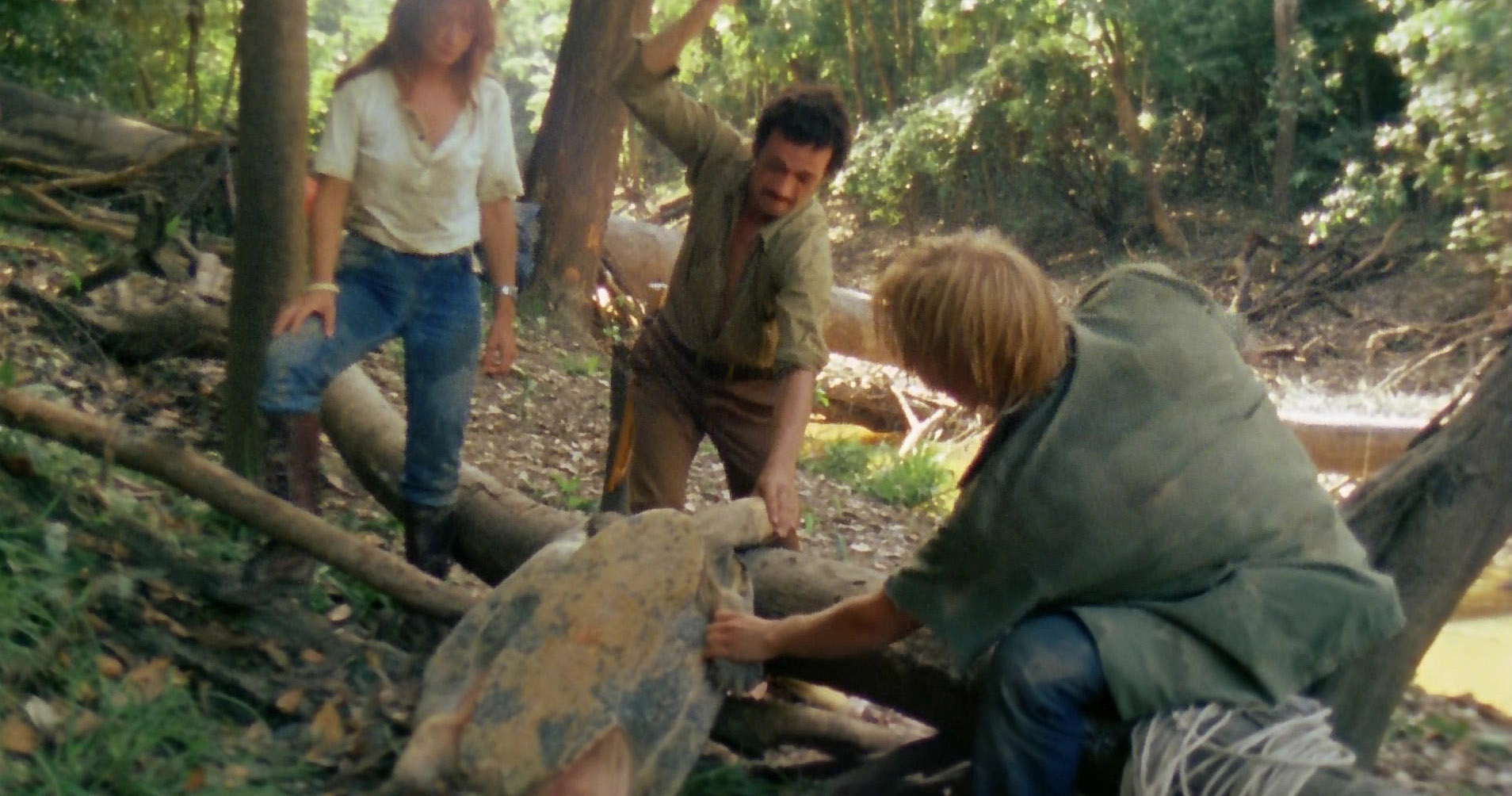
If there has ever been a film that’s title could be a synonyms with the word offensive, Ruggero Deodato’s “Cannibal Holocaust” is that film. Shot in a pseudo-reality documentary form that eerily and controversially blends reality and fiction, the dogma 95 style tale of a crew traveling deep into the remote unknown depths of a South American jungle to document a feral cannibalistic tribe is still to this day one of the most shocking and important films in the vast cannon of human artistry. “Cannibal Holocaust” was able to do for movies what Lenny Bruce and George Carlin did for comedy. It opened the flood gates of previously forbidden content and paved the way for future exploitation cinema.
With the purple heart bravery and visionary vigor to show just about every unfilmable instrument of destruction under the sun, it’s extraordinary that everyone involved in the making of the picture didn’t require a wheelbarrow to hall their balls around in. Stuffed as succulently full as the crust of stuffed crust pizza with realistic gore, torture, cannibalism, gang-rape, animal cruelty, and vivid mutilation, director Ruggero Deodato was actually put under arrests and charged with obscenity just ten days after its premier. It has been banned in over 50 countries and features the real onscreen deaths of six different animals.
Of the six animals that receive a cruel maiming, one in particular suffers a specially dire fate. When the crew is in need of food they look no further than a large wild tortoise for sustenance. Instead of humanely giving the turtle a fast painless death, they viciously sever its limbs and head as well as hollow it of its intestines.
Everything you see here is 100% real. All of it. And the camera doesn’t shy away from it. There is not a spat of compassion shown for the guiltless amphibian, although one actor admitted they cried after filming the scene. This is maybe the only torture sequence on this list that isn’t for everyone. Seeing a live turtle tormented and teased till decease is very disturbing and may even cause mental scaring. Especially if your name is Leonardo, Donatello, Michelangelo, or Raphael!
4. Martyrs – Skinned Alive
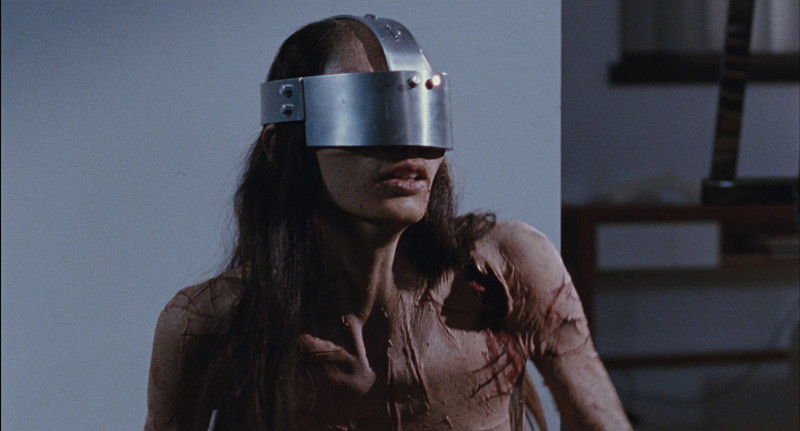
In french director Pascal Laugier’s dvd introduction to his 2008 torture-horror ballad “Martyrs”, he apologized for having created the film. He wasn’t completely serious, talking through a sort of sly dogish smirk, more aware of the extreme graphic content held within the dark chambers of his harrowing work. “Martyrs” is one of the most shocking and original horror films of the past twenty years. Period. It is also probably the second best and most realistic chronicle of a secret underground society ever (next to Kubrick’s “Eyes Wide Shut”).
Picture this, you’re sitting around your breakfast table on a careless, casual morning’s dawn, happily enjoying a meal with your family. Everyone’s joking. Laughing. Having a good time. The doorbell chimes. Your father struts easily over to answer it. Then…. BANG! An unidentified intruder sends two exploding buckshots through his chest.
Before you can even process the image of your Dad sucking on his last breaths through chokes of blood, the intruder enters. Aims. Fires a round into your Mom’s skull, spraying a shower of spoiling blood onto you and your sister. You sit there covered in the insides of the one who raised you, the one who sang to you so sweetly at night, as your sister flees to the bedroom. Wallowing in tears. The crack of the shots still ringing in your ears. There is no one left to protect you. It’s just you, and the barrel of a smoking shotgun.
This is a scene of pure brilliance that plays no more than 15 minutes into Pascal Laugier’s occult revenge masterwork “Martyrs”. If that’s where it starts imagine where it ends… Excruciating torture, self mutilation, and quite possibly the scariest fictional monster ever to be captured on film are just a few of the gut sinking scenarios gratuitously flexed during this grim descent into hell. Yet, as with most exploitation films, there is one infamous scene that after being consumed is forever associated with the picture and for some even the very word “Martyr”.
Have you ever seen someone get skinned alive? Well you won’t exactly see it within “Martyrs” (unless you are watching the subpar American remake). But, what you will see, is the result of someone being skinned alive. A fileted human carcass hung up like some educational display of muscular anatomy. Except this display is alive. Alive and breathing with not a cell of skin left but a face. Like a serial killer cadaver.
The makeup work here is stunningly pragmatic. The veins, muscles, arteries, and blood all look exactly how you would imagine them to look and Laugier makes his knowledge of this clear by holding the camera on the dissected model for multiple agonizing extended lengths so the viewer can question its authenticity. There really are no words to duplicate the scaring effect of this one. It just has to be seen to be believed.
3. Audition – Wire and Needles
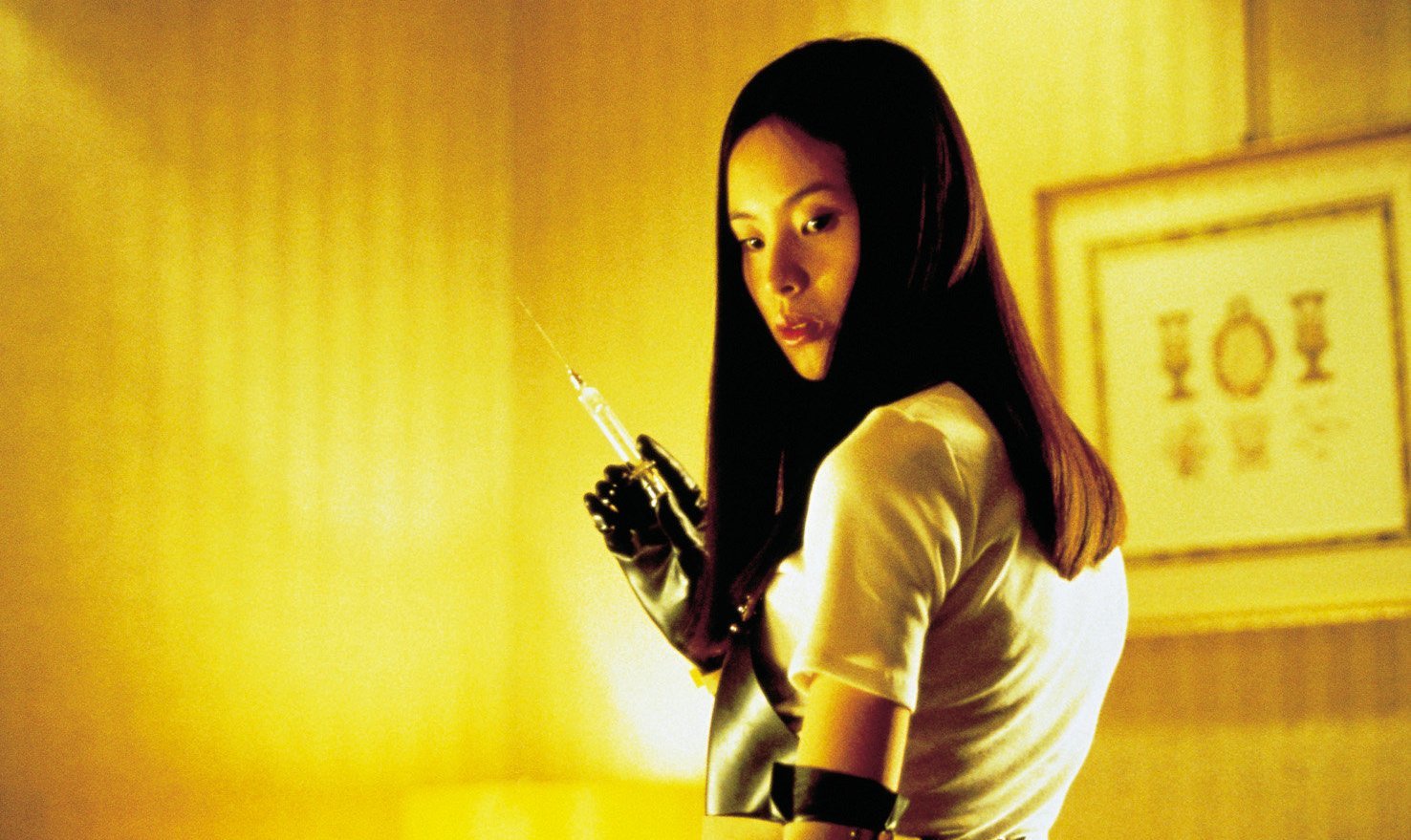
One of the many positive gains from indulging in foreign cinema is the opportunity to see things one could never witness in the USA. Due to the differences in cultural norms, practices, and forms of thoughts and ideas, movies from across the globe tend to feel much more exciting, fascinating, and spontaneous than anything Americans are normally exposed to or capable of.
Some of the greatest films ever conceived have toiled in obscurity and been buried alive due to that mere insignificant fact that they are foreign. But with the increase in ease of access to previously inaccessible foreign conjurations, there is hope that foreign movies can soon just be referred to and celebrated as “movies”.
One continent that has seen an especially vast benefit in the increased accessibility of cinema is that of Asia. Films such as Kim Jee-woon’s stark serial killer study “I Saw The Devil”, Wong Kar-wai’s striking meditative romance “In The Mood For Love”, and Park Chan Wook’s mind bending revenge overture “Oldboy”, are amongst the flagship titles leading a wave of surging popularity across countries other than the ones that produced them. In recent years however, there hasn’t been an Asian director with as much cult credibility as outlandish B-Movie maestro Takashi Miike.
Miike’s style of filmmaking is infeasible to put a finger on. Some call him an experimental master of horror, while others see him as a screwball powerhouse of action. Whatever the case, Miike has sculpted an impressively prolific library of visual and sensory nirvana with each work uniquely unparalleled in their execution, tone, and structure. Having held a career since 1990 and with over 100 films to his name, one would imagine that Miike’s name would already be a household item by now. But it wasn’t really until 1999’s Hitchcockian romance “Audition” that he began gaining the international notoriety he deserved.
“Auditon” coyly examines the fear that every person feels when embarking into the uncertain scourge of the dating pool. That the one sitting pretty, across your reserved spotless linen table-cloth array of fine china may not be who they appear to be. When middle-aged widower Shigeharu Aoyama (Ryo Ishibashi) decides he is finally ready to remarry, his movie producer friend, Yasuhisa Yoshikawa (Jun Kunimura), sets up a series of hoax auditions to aid in Aoyama finding of another commendable candidate.
Out of thirty young beauties, Aoyama chooses the socially awkward, pale doll Asami (Eihi Shiina) for her similar philosophies and feeble wounded-puppy personality. Hitting it off rather stupendously, Aoyama ignores certain strange aspects of Asami’s unbalanced past and family life due to the blindness of love. This turns out to be a huge mistake, as Asami begins to reveal that she isn’t exactly the innocent little angel Aoyama sought her to be.
If you’ve already seen this one, you know Asami turns out to be a reprobate feminist warrior who slaughters shallow men for pleasure. By the time Aoyama and the audience come to realize this truth, it is far too late. One quiet night, Asami poisons Aoyama’s beloved bourbon with a paralyzing potion that causes him to become entirely incapacitated.
As Aoyama squirms in shock on the cold carpet floor, Asami calmly suits herself up in butcher gear and prepares a white plastic sheet bed. Once everything is prepared, she rolls Aoyama’s struggling paralysis onto the white mat and injects a needle into his throat with a serum to silence his screams and pleas. Next she acquires a bundle of long gaunt needles and one by one begins inserting them, in no hurry, into her specimen’s torso while in a high pitched birdish chirp she repeats the words: “deeper, deeper, deeper.”.
She continues until Aoyama’s stomach looks like that of a drunkards dart board and then threads a few needles more near his eyes just for safety. All the while Aoyama cannot move but feel every single stinging prick and slow stab. After he is made a human pin cushion, Aoyama’s foot is amputated via a sawing piano wire that Asami acquired during her days of ballet.
This scene serves all at once as a manically graceful sequence of penalty and a righteous lesson that may make even the whitest of white knights question his so called “chivalry”.
2. 120 Days of Sodom – The Ending Wrath
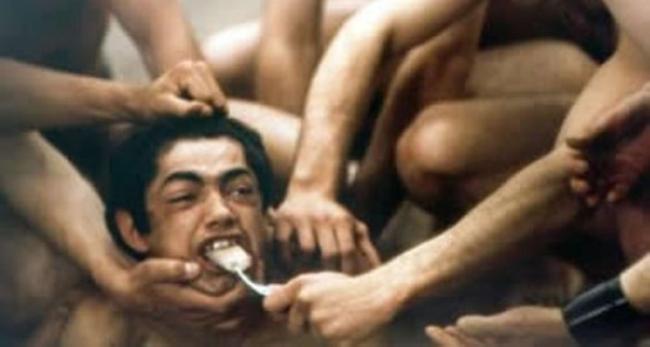
The unique, surrealist, Italian, poet, novelist, and filmmaker Pier Palo Passolini lived in so much mystery and oddity that he could almost be considered the 8th wonder of the world. He has succeed in adapting some of the most implausibly dense novels, began his renowned poetry at the ripe age of seven, and the circumstances of his quaint death remain unsolved to this very day.
A magnificent genius that time forgot. His stream of conciseness films are told through the eyes of a man with a perspective that no other man nor beast could ever come close to matching. They are peculiar puzzles and obscure brash comedies meshed together into beautifully framed eccentricities. They transcend the meanings of taste and taboo in an unpretentious fashion and make light of the darkest of life’s tragedies and indecent salutations.
The tragedy of his best known work, “Salo or The 120 Days of Sodom”, is that it is far from being his best. Still it is one of the earliest examples of uncompromising cinema and an absolutely hypnotic, intelligent critique of corruption, politics, and societal degradation. Perhaps his most cynical and bleak product, “The 120 Days of Sodom”, unravels in a style not so dissimilar to his other masterpieces.
There is a thin but obscure plot that stands simply as a playground for Passolini to frolic his musings. The story here consists of a powerful patriarchy that seeks out peasant youths to use as pawns in their animalistic sexual desires and most deviant fantasies. Young men and women alike are taken away as prisoners to a secretly sequestered mansion where, for 120 Days, they are beaten, sodomized, and forced to eat feces by their captors.
Passolini keenly conducts the minimalist narrative as a taut crescendo of heinous acts. As if he intended the viewer to feel the same detrimental effects and torture as the slaves depicted in the film. He begins with something as simple as forced kidnappings and rapidly follows with scene after scene of growing atrocities. Just when one believes the director has gone as far as his fabricated conscience will allow, he hits one with something far more obscene and difficult. Of course, a build as revoltingly grandiose as this would not be complete without a nice ribbon-tying ending…
After the meek, powerless servants have been repeatedly raped, beaten, and treated as dogs for a time that seems without end, the ones who survived the brooding terrible are forced to participate in what is referred to as “The Circle of Blood”. Victims are gifted a blue ribbon (how’s that for a ribbon-tying ending?) and then shortly after put viciously to death in a variety of unthinkable executions.
The overseers swap turns sitting highly upon a royal throne, spectating eagerly through binoculars and salivating with joyful perverted smirks carved across theirs mean faces while their slaves are branded, scalped, hung, burned, whipped, and gouged of their tongues and eyes. Once the celebration is all said and done, two of the mansion’s guards waltz to a fine tune together as if nothing of meaning had ever happened over the last 120 Days of Sodom.
Don’t let the film’s extremely graphic content shy you from checking it out though. Save for the hard to watch cruelty, “Salo” is an utter masterclass in directing, acting, cinematography, and satirical writing.
1. Ichi the Killer – Tempura
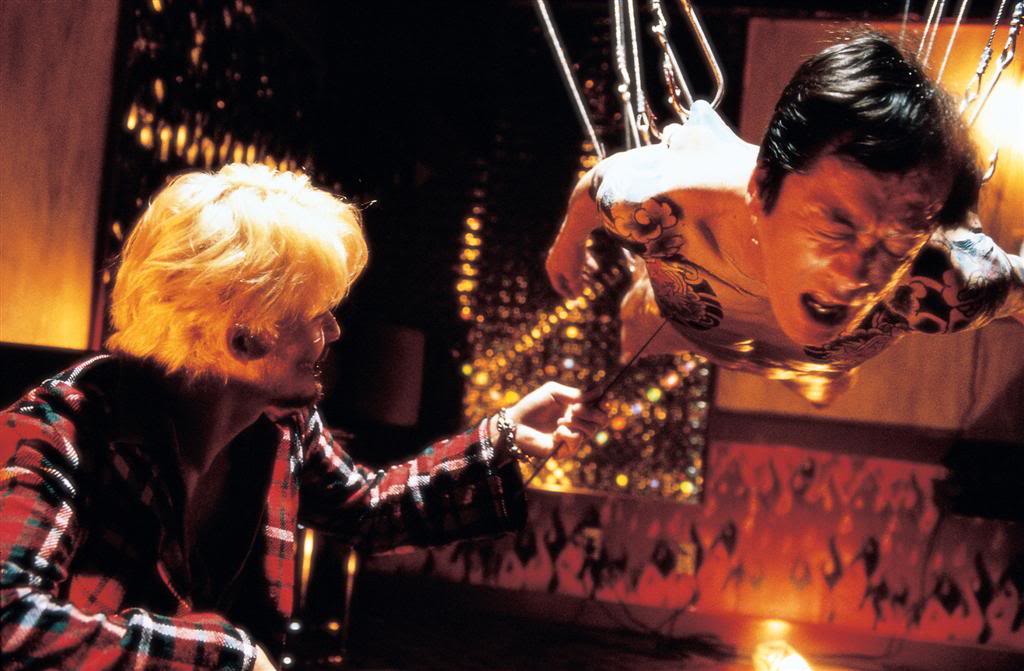
There is no better way to end this list than with another opus from the out-of-control master himself: Takashii Miike. He is the sole director mentioned here who can wholly and sincerely make even the most depraved and apathetic of us oblivion seekers question the horrors we are purposefully witnessing. Even Eli Roth and Quentin Tarantino, two of the sickest minds in cinema history, have sited Miike as a primary influence and practically a lord of derangement.
Miike’s completely insane, over the top, pop-art studded yakuza fable “Ichi the Killer” is the very sum of the coarse degeneracy and savage immorality he is capable of. It is a celebration of depravity. A kind tribute to the lowest of human behavior. It’s almost as if there isn’t a frame within the picture that doesn’t feature a display of vulgarity, rape, murder, torture, or some sort of ludicrous indecency and it is also the only film ever to attribute a title sequence written in actual human ejaculate (alleged).
All the same, “Ichi the Killer” plays like an adult cartoon. Juxtaposing some of the most fucked up characters of all time next to some of the most outlandish antics ever aroused, the film fantastically succeeds in bringing the looney, mad flavor of anime and Manga into the real world without even echoing the slightest hint of hokey obtuseness.
Beyond memorable in ever sense of the word, “Ichi the Killer” also brings to actualization two of most inventive characters that could very well rank among the same A-Class stature as Vito Corleone, Tyler Durden, and Frank Booth. Being neither antagonist nor protagonist while somehow being both at the same time, disturbed anti-hero super-hero “Ichi” and yakuza right hand man “Kakaharu” are sure enough to become the future legends of cinema.
Kakaharu alone, with his Glasgow smile and dead as dirt stare, could very well be the most psychotic character of all time. He is a man who lives and breathes for the sole idea of mindless violence. His hobbies include self mutilation, murder, torture, sadomasochism, and studying the human body.
Throughout the film he exercises his unquenchable thirst for turbulence in too many unthinkably grotesque ways. He slices off his own tongue, yanks a fellow’s cheek until it peels from his skull, and a grinds a man’s punch to a nub with nothing more than his teeth. But perhaps the scene that amounts his raving mental psychopathy the best is a scene called “Tempura”.
In the dingy basement quarters of yakuza club’s head office, Kakaharu artfully cooks shrimp in a bubbling vat of scalding oil. Meanwhile, a possible traitor dangles helplessly from the ceiling like a pinata upon a harness designed of hooks rung deeply into the tattooed skin of his back. As if it is no more than a joke, Kakaharu approaches the squealing man and pokes a sharp steel chopstick into his cheek until in pops through. Before jerking it back out, he takes a second to lever the tool while it is still stuck inside. Ravishing the moment. Smirking with total bliss.
For his next trick, he thrusts the chop stick into the bottom fat of the man’s chin, forcing it all the way through his tongue and out the other side. Still smiling proudly, Kakaharu retrieves the pot of boiling grease and dumps it across the man’s back and head as if he is washing a cat clean.
The exposed flesh sears and singes the sound of a boiling egg as the suspended man scalds to blisters and vomits dark thick blood. But what makes this scene most disconcerting to the viewer is the fact that when someone finally catches Kakaharu in the act of mangling his subject and inquires upon his drastic ways, he flatly replies: “Oh… Just a little torture” as if he was caught carrying out something as insignificant as reading the morning news.
Honorable Mentions: “Hostel Part I” – I Wanted to Be Surgeon, “Silence” – Apostatize, “Arabian